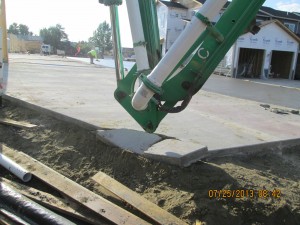
From the Plains to the Patch, Benefits of Construction Inspection
There is one saying that a newcomer will take to heart in western North Dakota, “Welcome to the Bakken.” This quote often sums up the rapid pace of growth in areas of housing, infrastructure, energy, transportation, commercial, and industrial developments. It also provides a means to take humor in the hard working atmosphere driven by the oil and natural gas production in the Bakken Oil Field. In the rapidly growing environment, construction quality control, or construction inspection, may not be prioritized. Lack of inspection may lead to poor workmanship, heightened construction costs, and no documentation of construction means and methods. Construction Inspection is a vital part of a project life and vital to the development of young engineers because it provides written documentation of day to day construction activities, the owner’s bests interests are represented on site through a familiar communicator, administers payment and bond release applications, opens work-relationship opportunities, can lead to additional services, and is a great hands on learning experience.
Written and photo documentation of construction means and methods, problems encountered, conversations, and day to day activities is an important part of project monitoring. MSU MDOT design team administrator Mr. Scott Keller has experience in the difference written documentation can make in a litigation, and as he is often quoted saying, “I’ll be honest with you, paper is cheap.” Paper documentation inspection reports indicate whether or not the work is being accomplished in accordance with the construction drawings and specifications. The reports also detail weather conditions, labor force, equipment, work in progress, and reports may include photos, work tickets, purchase orders, hauling stubs, and other applicable documents. Inspection is also important in confirming that the owner is receiving a working product through startup and acceptance testing. An owner’s representative on site witnessing the testing ensures that the tests are taken in accordance with the specification and provides documentation to all parties of a pass or fail status. An inspector also ensures that municipal, state, or federal regulations are maintained.
Construction inspection provides an on-site representative who monitors the quality of work in place. Many engineering specifications and project drawings require special inspection throughout the life of the project. For example, paraphrasing the McKenzie County Courthouse Project, “The owner or registered design professional in responsible charge shall employ a special inspector to provide inspection during construction … The special inspector shall be a qualified person for inspection of the particular type of construction or operation requiring special inspection.” The inspector is physically on site documenting work and selectively providing recommendations when questions arise. Communication between owner, engineer, architect, general contractor, and subcontractors is facilitated through the inspector. An inspector’s role is to communicate construction progress and problems to the applicable party. When difficult questions are encountered during construction, the inspector directs the question to the appropriate recipient. Daily reports summarizing work completed and points of interest are also distributed to each party appropriately.
The inspector provides the vital role of composing or assisting in creation of Contractor Applications for Payment. The owner should never have to pay for work that is not actually in place. Roles of the inspector may include providing an honest estimate of quantity work in place in units corresponding to the bid agreement. If required, materials stockpiled may also be evaluated, and applied to the Application for Payment. Bond Release Applications are also a part of the Inspectors duties, if required. Deficiencies in the final product, or punch list items, are monitored extensively by the inspector. A site walkthrough between the owner and inspector should take place before releasing any bonds, ensuring that the owner is aware of the punch list items.
During inspection, relationships are developed with all parties involved in the project: owner, developer, engineer, architect, general contractor, subcontractors, and municipal. Work related relationships form easily when the inspector can provide valuable and knowledgeable information. Contacts will keep coming back with their questions and potential work opportunities that benefit the inspector and his or her employer. One humorous saying applicable to a successful inspector is stated as, “Too much work is a good problem to have.” Inspection opens other opportunities in the engineering field, such as design, construction administration, construction surveying, and materials testing. Showing leadership and competence in inspection duties indicates those same qualities will appear when practicing engineering design and project management.
Hand’s on inspection instructs young engineers in real world construction methods that will transfer into engineering design. An inspector will develop practical construction skills and use construction drawings and specifications to answer questions on site. Field experience provides insight on what makes a good specification and set of construction drawings, which could later be applied to design.
Because the owner benefits from having a day to day log of construction activities, has a representative with their interests at heart on site, and obtains accurate and verified payment and bond release applications, construction inspection is highly recommended. In addition, the inspector benefits by forming professional relationships, opening opportunities for additional services, and gaining real world knowledge which can be applied to design. There is a low cost to benefit ratio of utilizing a competent construction inspector for quality control and communication. The inspector can make recommendations on site with the owner’s best interest in mind. Inspectors provide written and photographic documentation describing day to day activities and work in place during the life of the project, which may help catch problems before they reach a crisis level or become viable evidence during litigation.
Contribution by Mark Juras, E.I.T., Watford City, North Dakota






